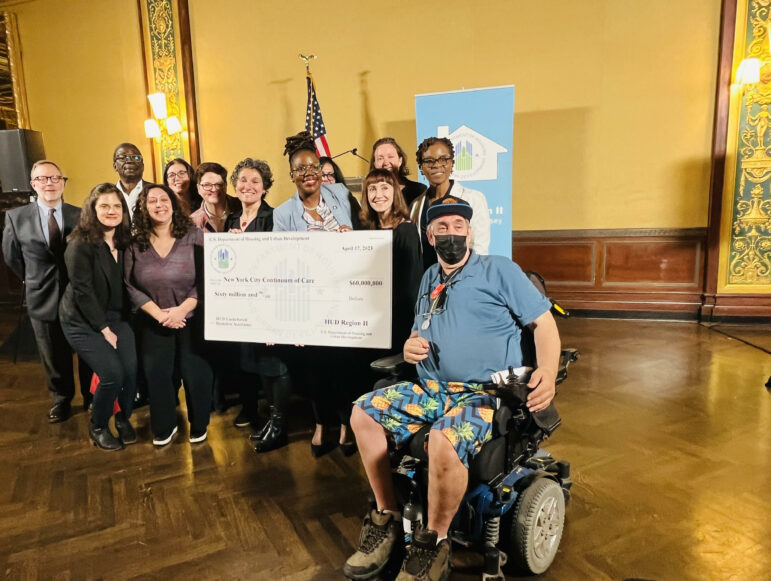That funding will go towards the New York City Continuum of Care (CoC) to address street homelessness, including the creation of a centralized “unit” to connect people with outreach teams and resources for finding shelter, healthcare and stable housing.

Tatyana Turner
HUD officials with representatives from the city’s Department of Homeless Services, HPD and nonprofit Breaking Ground at the funding announcement Monday.
The Department of Housing and Urban Development (HUD) released a second wave of grants and housing vouchers this week to aid people experiencing unsheltered and rural homelessness across the country—including $60 million earmarked for New York City.
That funding will go towards the New York City Continuum of Care (CoC) to address street homelessness, including the creation of a centralized “unit” to connect people with outreach teams and resources for finding shelter, healthcare and stable housing, according to Marion McFadden, HUD’s principal deputy assistant secretary for community planning and development.
It will also support initiatives already underway, like the city’s Street to Home Pilot, which provides street homeless New Yorkers—people sleeping in public spaces like subways, sidewalks or parks—directly with apartments and support services.
Additionally, HUD will provide 612 “stability” or Housing Choice Vouchers, rental assistance for people experiencing or at risk of homelessness, including veterans, survivors of domestic violence and survivors of human trafficking. NYCHA will receive 377 of the vouchers, while the rest will go to the city’s Department of Housing, Preservation and Development.
Last year, more than 582,500 people experienced homelessness on any given night across the nation, 40 percent of whom were unsheltered or individuals who slept in cars, tents and parks.
“Between 2020 and 2022, we saw unsheltered homelessness increase by 3.4 percent,” McFadden said before presenting a giant check to the CoC. “That is absolutely unacceptable, but it is solvable.”
In New York City alone, more than 74,000 people slept in a shelter Monday night. The number of street homeless New Yorkers is harder to track: the city’s annual HOPE census, conducted in January, estimated there were 3,439 unsheltered residents, though advocates say that’s often an undercount.
The Adams administration has paid particular focus to street homelessness, though many of its tactics—which included driving unsheltered residents out of the subway system, and increased “sweeps” of public encampments—have been criticized by homeless people and housing advocates.
The city also opened a “Welcome Center” in the Bronx last year specifically for unsheltered residents, and emphasized the need for more “Safe Haven” and stabilization beds across the city, which tend to have less restrictions than traditional congregate shelters that many street homeless New Yorkers avoid. The number of people sleeping in Safe Havens each night has hovered around 1,500 for the last year, according to data tracked by City Limits.
HUD said Monday’s funding announcement is “the first of its kind” that pairs grants and housing vouchers, which it said will assist 100,000 people out of homelessness and add 40,000 housing units across the country under the federal House America program.
McFadden said that the city’s CoC program will also connect with rental owners, agents and property managers to identify and lease apartments to New Yorkers with vouchers, who often face discrimination from landlords and real estate brokers.
Last year, the city received another batch of 7,800 federal housing vouchers, but less than 20 percent of tenants who received them had actually found an apartment to rent more than a year and a half after they were issued, City Limits reported at the time.
“Everyone here today is aware of the challenges homelessness brings and many of you work tirelessly to find homes for those New Yorkers in need,” Alicka Ampry-Samuel, HUD’s Regional administrator for New York and New Jersey, said during the funding announcement Monday at the Prince George building in Midtown Manhattan. “Many of you have experienced living on the street and the instability of not having a place to call home personally.”
The Prince George, a former hotel, is now an affordable housing project for more than 400 individuals who are low-income, formerly homeless or live with HIV or AIDS. It’s run by social services provider Breaking Ground, which received $11.9 million of the HUD funds.
“Unsheltered homelessness is not new but the pandemic and the aftermath have created new challenges here in New York City and across the country,” said Brenda Rosen, Breaking Ground’s president and CEO.
Matt Dick, an apparel maker, is a resident at one of the units at The Prince George. The 51-year-old moved to New York from San Francisco for a job in November 2018, but lost his job a few months later, and struggled with finding a place of his own. A friend referred him to a tenant organization, Community Action for Safe Apartments (CASA), for assistance.
Between the time of losing his job and the height of COVID, Dick lived in three different Single Room Occupancy units before connecting with Breaking Ground to find his current apartment.
“It allows me to spread my wings again,” Dick said. “I never thought my neighbor would be the Empire State Building.”








